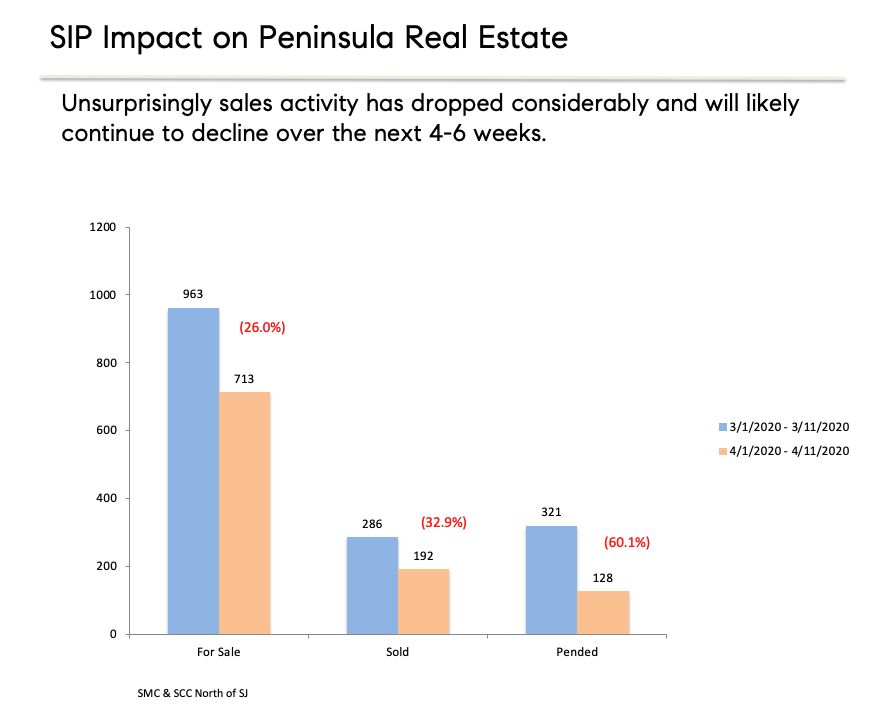COVID-19/SIP Impact on Real Estate
- Rob Purnell

- Apr 16, 2020
- 3 min read

We are now 4+ weeks into the Shelter In place (SIP) orders brought on by the Coronavirus pandemic rampaging through the country and around the world. The overarching theme in our lives continues to be uncertainty; uncertainty around when SIP will be lifted, the trajectory of the pandemic itself, the global economy, and our local real estate markets.
But just like information around COVID-19 itself, there is a lot of misinformation and unsupported beliefs regarding the performance of our housing markets. While it is still a fluid situation, there are enough early indicators to be able to form a reasonable view about what the future looks like as the pandemic wanes and our attention turns to economic recovery.
The pervading opinion is that real estate markets are frozen solid and set up to suffer a major downturn in the near future. But the current data, both quantitative and qualitative, point to the potential for a strong and rapid rebound once we're released from house arrest.
Most economists and industry experts believe that housing will lead the US out of the coming

recession. There are good reasons to believe this. First, during three of the past five major US recessions, real estate performed exceptionally well, delivering annual appreciation between 3.5% and 6.6%. In the 1991 recession housing had a modest retraction of 1.9%. It was only in the 2008 recession brought on by the housing crisis that real estate suffered significant losses of upwards of 20%. I have already written extensively on why the 2008 housing crash will not repeat itself today. (Watch video presentation.) Suffice it to say that nothing has changed in this regard since my original analysis.
Turning to the current state of our local markets, while sales activity has dropped off considerably since SIP orders were issued if we take a more granular look at underlying performance metrics there are indications that the markets are poised for a quick and robust return to normal.

The Bay Area essentially shut its doors for business on March 16. Comparing sales activity for the first 11 days of March, before SIP, to the first 11 days of April, after SIP, we see that inventory has dropped 26% and unit sales volume has dropped 33%. That is considerable, and likely underestimated considering this is the peak spring selling season and both these metrics would be rising. Further, pended sales have dropped by 60%. Given typical sales cycles, this implies we are likely to see sales volume continue to drop for the next 4-6 weeks.
None of this is unexpected given the circumstances. Also, since there is a month lag in typical real estate reporting, expect April-end numbers to look very bad since they will reflect March activity.
The Good News
When we dig a little deeper the underlying trends begin to look much better. There were significant blips when SIP orders were first issues - a natural and expected panic reaction - but there has been a quick return to normal, even positive trends, albeit at lower absolute volume levels.

Pulled Properties (purple line) - the number of for-sale properties being pulled from the market spiked immediately when SIP was ordered, but quickly returned near normal levels and has continued to decline.
New Listings (green line) - homes being put on the market are trending strongly up since SIP was initially ordered. Despite the continued restrictions on being out in the world new housing inventory continues to come to market.
Pended Sales (blue line) - the number of homes going into contract has turned up strongly over the recent week. While it's too early to call it a trend it bears watching closely. If these numbers continue to go up as we get closer to SIP being lifted we can expect home sales to spike through the summer and into the fall.
Days on Market (below) - the properties that are coming to market today continue to sell at a rapid clip. This is a testimony to how well and how quickly the real estate industry has adapted to the circumstances, deploying an array of creative technologies and solutions to continue to serve buyers and sellers.
Pre-approvals - while anecdotal, in conversations with numerous mortgage lenders I'm told there has been a surge in applications for mortgage pre-approval. This would indicate considerable buyer demand prepared to jump into the market as soon as we reopen for normal business.

********************************
While it is early and significant uncertainty remains, there are enough positive indicators to feel quite confident that our real estate markets will recover quickly. It is easy at times like this to see doom and gloom, but there are silver linings everywhere. Economically, real estate is going to be one of those silver linings.
If you had a plan to buy or sell prior to the COVID-19 pandemic, it is likely still a good plan. You may just have to make some tactical adjustments.







Comments